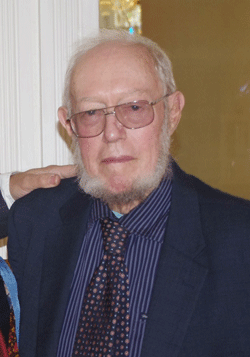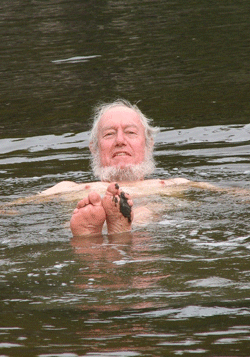A prolific educator who revolutionized understanding of Earth’s magnetic field

On 7 September 2021, the Department of Marine Geosciences at the University of Miami, USA lost one of its most important and influential faculty, Dr. Chris Harrison.
RSMAS
Chris Harrison joined the faculty at the Rosenstiel School of Marine and Atmospheric Sciences (RSMAS) in 1967 and was pivotal in the rise of RSMAS to one of the premier marine schools in the world. He was recruited to what was then called the Marine Laboratory at the University of Miami through the efforts of Fritz Koczy and Cesare Emiliani, and joined an impressive group of (at the time) young faculty including Frank Millero, Joe Prospero, Enrico Bonatti, Kurt Bostrom, Jose Honnorez, and Harry de Ferrari.
In 2015, Chris retired becoming an emeritus faculty. During his time at University of Miami, he served both as chairman (1976 – 1983) of the Division of Marine Geology and Geophysics, Chair of the RSMAS School Council, and Dean of the School (1986 – 1989). Outside the school he was very active in the American Geophysical Union (AGU), serving on numerous AGU committees and as general secretary during the period when the AGU grew from a very small niche society to its present position as the most important and dominant geoscience organization, extending far beyond its geophysical routes.
Magnetism and deep-sea drilling
Chris Harrison attended the University of Cambridge where he completed his BA in 1960 and then studied paleomagnetism for his PhD (1966) in the Department of Geodesy and Geophysics. This and his later postdoctoral work at Scripps Institution of Oceanography contributed to our understanding of secular variations in Earth's magnetic field and the origin of magnetic anomalies.
Perhaps his most important contribution was the discovery that sediments could record Earth’s magnetic field, published in Nature in 1964. This finding was seized on by others and was one of the important proofs of the theory of plate tectonics.
Chris was very active in the early days of the Deep-Sea Drilling Project and represented the Rosenstiel School on many of the advisory panels for that program and its successor the Ocean Drilling Program. Later he published papers on a wide variety of geophysical topics related to plate tectonics, sea level change, and rates of continental weathering and mountain building. His last paper was published in July 2021 and summarized from his personal view point the history of the theory of plate tectonics and importance of Earth’s magnetic field in the development of this theory.
Generosity
Chris was also a prolific educator having served as the principal advisor for over 30 MS and PhD students, many of whom later became important researchers and educators. During his career, Chris, Martha and their family were more than generous, opening their home to foreign students during festive events such as Christmas and Thanksgiving.
Chris leaves behind his wife Martha, two children Ariel and Ewen, and grandchildren, Rowan, Helen, Phoebe, Rosie. They and his colleagues will miss him greatly.
By Peter Swart
The full version of this obituary appears below. Editor.
Christopher G.A. Harrison (1936 – 2021)
On September 7th, 2021 the family of the Department of Marine Geosciences at the University of Miami lost one of its most important and influential faculty, Dr. Chris Harrison.
Chris Harrison had been a faculty at the Rosenstiel School of Marine and Atmospheric Sciences (RSMAS) since 1967 and was pivotal in the rise of RSMAS to one of the premier marine schools in the world. He was recruited to what was then called the Marine Laboratory at the University of Miami through the efforts of Fritz Koczy and Cesare Emiliani and joined an impressive group of (at the time) young faculty, including Frank Millero, Joe Prospero, Enrico Bonatti, Kurt Bostrom, Jose Honnorez, and Harry de Ferrari.
In 2015, Chris retired becoming an emeritus faculty. During his time at University of Miami, Chris served both as chairman (1976 – 1983) of the Division of Marine Geology and Geophysics, Chair of the RSMAS School Council, and Dean of the School (1986 – 1989).
Outside the school, Chris was very active in the American Geophysical Union (AGU), serving on numerous AGU committees and as general secretary during the period when the AGU grew from a very small niche society to its present position as the most important and dominant geoscience organization extending far beyond its geophysical routes. Other than the University of Miami, the AGU was always one of his passions. Although Chris would become very animated about changes in both organizations with which he disagreed, his love for both surprisingly never wavered.
Chris made his career in the US, but his trip to North America in the early 1960s was not his first venture to that continent. Chris was a child of the second World War, and like many other youngsters at the time was evacuated with his brothers and mother to Massachusetts in the US to avoid bombing and possible invasion, while his father remained behind working on the war effort. One of Chris’s many stories involved the return of his family back to the UK during a period in which submarines were still very active in the Atlantic. His mother had decided to return to the UK and the news of her decision had not reached Chris’s father until the convoy had already set sail from the US. According to his father there had just been a major increase in German submarine activity and the convoy was lucky to escape.
After the war, life resumed slowly to normal in the United Kingdom with rationing and national service still in effect. Chris completed his national service in the British Army Corps of Royal Engineers (1955 – 1957) as a second Lieutenant and was posted all over the world, including in India, Japan, and Korea.
Afterwards Chris attended the University of Cambridge, where he completed his BA in 1960 and then studied paleomagnetism for his PhD (1966) in the Department of Geodesy and Geophysics. This and his later postdoctoral work at Scripps Institution of Oceanography contributed to our understanding of secular variations in the Earth's magnetic field and the origin of magnetic anomalies.
Perhaps his most important contribution was the discovery that sediments could record Earth’s magnetic field, published in Nature in 1964. This finding was seized on by others and was one of the important proofs of the theory of plate tectonics.

Chris was very active in the early days of the Deep-Sea Drilling Project and represented the Rosenstiel School on many of the advisory panels for that program and its successor the Ocean Drilling Program. Later he published papers on a wide variety of geophysical topics related to plate tectonics, sea level change, and rates of continental weathering and mountain building. Some of these papers originated from enthusiastic discussions amongst the young and dynamic RSMAS faculty during lunch in the RSMAS cafeteria. At the time the school was non-departmentalized, which led for free and dynamic exchange of scientific ideas between faculty. Cesare Emiliani, perhaps the most important scientist that has worked at the University of Miami, classified Chris as one of the 290 most influential scientists of all time, a list that included amongst many others Pythagoras, Copernicus, Descartes, Darwin, Einstein, Curie, and Hawking.
Chris’s last paper was published in July 2021 and summarized from his personal view point the history of the theory of plate tectonics and importance of Earth’s magnetic field in the development of this theory.
Chris was also a prolific educator having served as the principal advisor for over 30 MS and PhD students, many of whom later became important researchers and educators. During his career, Chris, Martha and their family were more than generous, opening their home to foreign students during festive events such as Christmas and Thanksgiving, holding legendary defense parties at their house in the deepest jungles of Coconut Grove, parties that more than often ended up in the swimming pool, and organizing numerous canoe trips throughout the Everglades and South Florida for the Department.
This remembrance of Chris draws on contributions from many of his close colleagues including Joe Prospero, Andrew Baker, and Larry Peterson, as well as his family. On a personal note, I would like to thank the foresight of the founder of RSMAS, Walton Smith, also an Englishman, who endowed the school with its own bar. Walton Smith considered that a bar was essential to the scientific functioning of a research institution, and over the past 30 years Chris and I were probably its most regular patrons, where we exchanged numerous stories, experiences, likes, and dislikes.
In addition to exploring the Everglades in his canoe, Chris particularly loved climbing Monroes in Scotland, hiking in many other places around the world and all the travel involved in attending geological meetings associated with his work. Chris leaves behind his wife Martha, two children Ariel and Ewen, and grandchildren, Rowan, Helen, Phoebe, Rosie. They and his colleagues will miss him greatly.